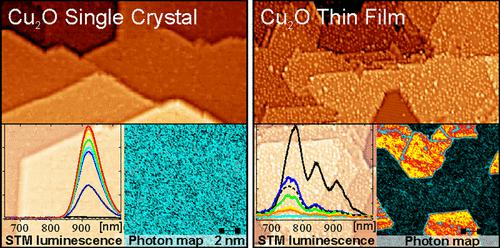当前位置:
X-MOL 学术
›
ACS Photonics
›
论文详情
Our official English website, www.x-mol.net, welcomes your
feedback! (Note: you will need to create a separate account there.)
Luminescence from Cuprous Oxide in a Scanning Tunneling Microscope: Competition between Plasmonic and Excitonic Response
ACS Photonics ( IF 6.5 ) Pub Date : 2022-10-13 , DOI: 10.1021/acsphotonics.2c01109 Alexander Gloystein 1 , Niklas Nilius 1
ACS Photonics ( IF 6.5 ) Pub Date : 2022-10-13 , DOI: 10.1021/acsphotonics.2c01109 Alexander Gloystein 1 , Niklas Nilius 1
Affiliation

|
Conventional photoluminescence and light emission spectroscopy with a scanning tunneling microscope (STM) are used to compare the optical response of bulk Cu2O(111) and 1–10 nm-thick Cu2O/Au(111) films. According to electron diffraction, X-ray photoelectron spectroscopy, and STM, both systems share identical structural and electronic properties and expose the same thermodynamically preferred (√3 × √3) R30° termination. Their luminescence behavior exhibits, however, distinct differences. While spectra of bulk Cu2O are dominated by the recombination of free and defect-bound excitons, a plasmonic response either from interface or localized plasmons is detected for the supported films. The latter arises from electromagnetic coupling between the STM tip and the Au(111) support, whereby the Cu2O adlayer only controls the inelastic tunneling rates and thus the emitted intensity. Our paper discusses why the unique exciton response of Cu2O is covered by plasmon excitations in oxide films as thick as 10 nm. On this basis, intrinsic limitations of STM luminescence spectroscopy are addressed when exploring spatially confined optical modes in dielectric materials.
中文翻译:

扫描隧道显微镜中氧化亚铜的发光:等离子体响应和激子响应之间的竞争
传统的光致发光和光发射光谱与扫描隧道显微镜 (STM) 用于比较块状 Cu 2 O(111) 和 1–10 nm 厚的 Cu 2 O/Au(111) 薄膜的光学响应。根据电子衍射、X 射线光电子能谱和 STM,这两个系统具有相同的结构和电子特性,并具有相同的热力学优选 (√3 × √3) R30° 终止。然而,它们的发光行为表现出明显的差异。而块状 Cu 2的光谱O 以自由和缺陷结合激子的重组为主,检测到支持薄膜的来自界面或局部等离子体的等离子体响应。后者由 STM 尖端和 Au(111) 支架之间的电磁耦合引起,由此 Cu 2 O 吸附层仅控制非弹性隧道速率,从而控制发射强度。我们的论文讨论了为什么 Cu 2 O的独特激子响应被厚达 10 nm 的氧化物薄膜中的等离子体激元激发所覆盖。在此基础上,在探索介电材料中的空间受限光学模式时,解决了 STM 发光光谱的固有局限性。
更新日期:2022-10-13
中文翻译:

扫描隧道显微镜中氧化亚铜的发光:等离子体响应和激子响应之间的竞争
传统的光致发光和光发射光谱与扫描隧道显微镜 (STM) 用于比较块状 Cu 2 O(111) 和 1–10 nm 厚的 Cu 2 O/Au(111) 薄膜的光学响应。根据电子衍射、X 射线光电子能谱和 STM,这两个系统具有相同的结构和电子特性,并具有相同的热力学优选 (√3 × √3) R30° 终止。然而,它们的发光行为表现出明显的差异。而块状 Cu 2的光谱O 以自由和缺陷结合激子的重组为主,检测到支持薄膜的来自界面或局部等离子体的等离子体响应。后者由 STM 尖端和 Au(111) 支架之间的电磁耦合引起,由此 Cu 2 O 吸附层仅控制非弹性隧道速率,从而控制发射强度。我们的论文讨论了为什么 Cu 2 O的独特激子响应被厚达 10 nm 的氧化物薄膜中的等离子体激元激发所覆盖。在此基础上,在探索介电材料中的空间受限光学模式时,解决了 STM 发光光谱的固有局限性。











































 京公网安备 11010802027423号
京公网安备 11010802027423号